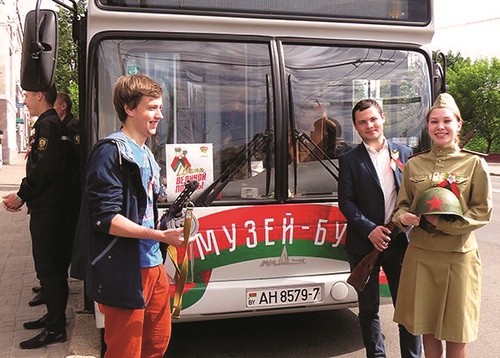The ‘Flowers of the Great Victory’ mobile museum has arrived in Vitebsk, inviting visitors to handle artefacts used in the heroic struggle of the Belarusian people against Nazi aggressors during the Great Patriotic War. A joint project by the Belarusian Republican Youth Union and the Federation of Trade Unions of Belarus, the bus has parked in Mayakovsky public garden in Vitebsk and is already proving a great success.

‘Flowers of the Great Victory’ bus-museum
Schoolchildren, students and older people have been taking photos beside a Shpagin submachine gun and the sword once owned by Marshal of the Soviet Union Ivan Bagramyan. Military reconstruction clubs have set up nearby also.
The co-ordinator and secretary of the Central Committee of the Belarusian Republican Youth Union, Victoria Mennanova, tells us, “We want our children to learn more about the history of their family and their country. We want them to know the history of the Great Victory earned in 1945, and to let no one distort or rewrite it.”
A new project was launched at the Cultural Centre in Vitebsk to coincide with the bus’ visit: Dialogue of Generations: Flowers of the Great Victory. About a hundred young Vitebsk residents, representatives of Government and non-governmental organisations have discussed youth problems, and possible solutions, delegates of the 5th All-Belarusian People’s Congress among them. The First Secretary of the Vitebsk Regional Committee of the Belarusian Republican Youth Union, Victor Glushyn, notes, “Our projects, such as Youth Day at the Slavianski Bazaar and the International Be-La-Rus Camp, on the Friendship Mount, are popular not only with locals but with foreign guests. We were the first in Belarus to create an IT student team. However, there are issues to be addressed. First of all, we need more employment opportunities for minors. There are a lot of 14 to 18 year olds eager to work but not enough jobs.”
By Sergey Golesnik











